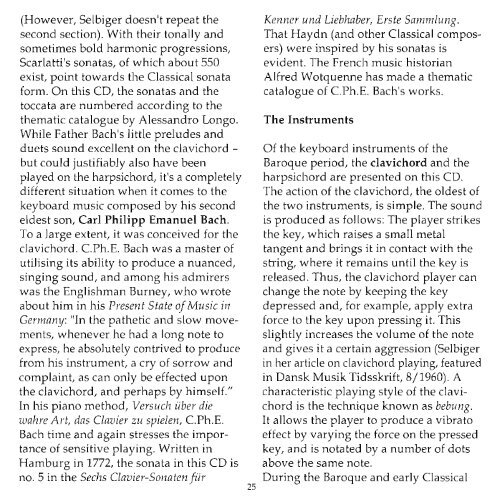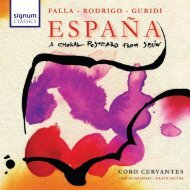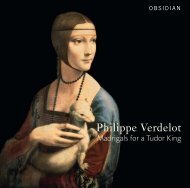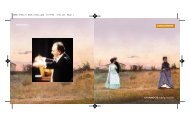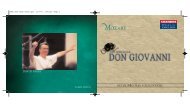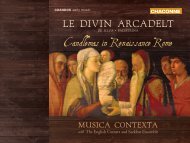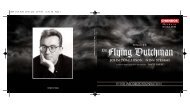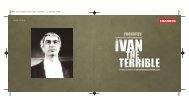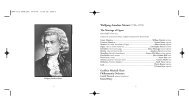Li..l'tt" S.lLiger - Chandos
Li..l'tt" S.lLiger - Chandos
Li..l'tt" S.lLiger - Chandos
You also want an ePaper? Increase the reach of your titles
YUMPU automatically turns print PDFs into web optimized ePapers that Google loves.
{However, Selbiger doesn't repeat the<br />
second section). With their tonally and<br />
sometimes bold harmonic progressions,<br />
Scarlatti's sonatas, of which about 550<br />
exist, point towards the Classical sonata<br />
form. On this CD, the sonatas and the<br />
toccdta dre numbered according to the<br />
thematic catalogue by Alessandro Longo.<br />
While Father Bach's little preludes and<br />
duets sound excellent on the clavichord -<br />
but could justifiably also have been<br />
played on the harpsichord, it's a completely<br />
dlfferent situation when it comes to the<br />
keyboard music composed by his second<br />
eldest son, Carl Philipp Emanuel Bach.<br />
To a large extent, it was conceived for the<br />
clavichord. C.Ph.E. Bach was a master of<br />
utilising its ability to produce a nuanced,<br />
singing sound, and among his admirers<br />
was the Englishman Burney, who wrote<br />
about him in his Present State of Music in<br />
Germany'. "In the pathetic and slow movements,<br />
whenever he had a long note to<br />
express, he absolutely contrived to produce<br />
from hls instrument, a cry of sorrow and<br />
complaint, as can only be effected upon<br />
the clavichord, and perhaps by himself."<br />
In his piano method, Versuclt r.iber die<br />
uahre Art, dss Claaier zu spielen, C.Ph.E.<br />
Bach time and again stresses the importance<br />
of sensitive playing. Written in<br />
Hamburg 1n1772, the sonata in this CD is<br />
no. 5 in the Sechs Claaier-Sonatenftir<br />
Kenner und <strong>Li</strong>ebluber, Erste Sammlung.<br />
That Haydn (and other Classical composers)<br />
were inspired by his sonatas rs<br />
evident. The French music historian<br />
Alfred Wotquenne has made a thematic<br />
catalogue of C.Ph.E. Bach's works.<br />
The Instruments<br />
Of the keyboard instruments of the<br />
Baroque period, the clavichord and the<br />
harpsichord are presented on this CD.<br />
The action of the clavichord, the oldest of<br />
the two instruments, is simple. The sound<br />
is produced as follows: The player strikes<br />
the key, which raises a small metal<br />
tangent and brings it in contact with the<br />
string, where it remains until the key is<br />
released. Thus, the clavichord player can<br />
change the note by keeping the key<br />
depressed and, for example, apply extra<br />
force to the key upon pressing it. This<br />
slightly increases the volume of the note<br />
and gives it a certain aggression (Selbiger<br />
in her article on clavichord playing, featured<br />
in Dansk Musik Tidsskrift, S/1960). A<br />
characteristic playing style of the clavichord<br />
ls the technique known as bebung.<br />
It allows the player to produce a vibrato<br />
effect by varying the force on the pressed<br />
key, and is notated by a number of dots<br />
above the same note.<br />
During the Baroque and early Classical


